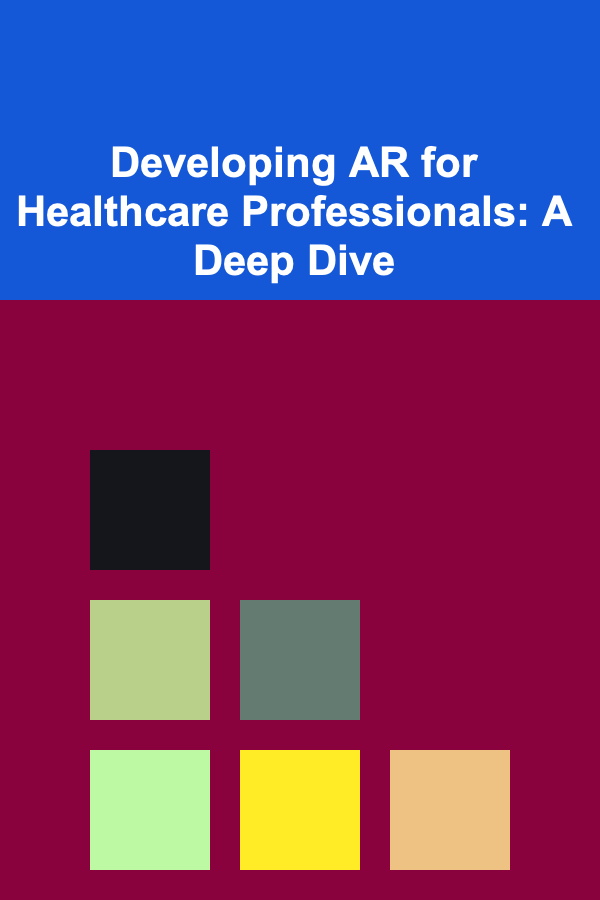
Developing AR for Healthcare Professionals: A Deep Dive
ebook include PDF & Audio bundle (Micro Guide)
$12.99$5.99
Limited Time Offer! Order within the next:

Augmented Reality (AR) is rapidly transforming various industries, and healthcare is no exception. AR applications hold immense potential to improve training, diagnosis, treatment, and patient care. This article provides an in-depth guide on developing AR solutions specifically tailored for healthcare professionals, covering essential considerations, challenges, and best practices.
Understanding the Landscape: AR in Healthcare
Before diving into development, it's crucial to grasp the diverse applications of AR in healthcare. These applications can be broadly categorized as follows:
- Surgical Training and Simulation: AR can overlay virtual anatomical structures onto a mannequin or even a real patient, allowing surgeons to practice complex procedures in a realistic and risk-free environment. This enhances surgical skills, reduces errors, and improves patient outcomes.
- Medical Education and Training: AR apps can provide interactive 3D visualizations of human anatomy, physiology, and pathology. Students can explore anatomical structures layer by layer, enhancing their understanding of complex medical concepts.
- Diagnosis and Treatment Planning: AR can be used to visualize medical images, such as CT scans and MRIs, in 3D. This allows doctors to better understand the patient's condition and plan treatment more effectively. AR can also assist in guiding procedures like biopsies and injections.
- Patient Education and Engagement: AR can help patients understand their medical conditions and treatment plans. For example, an AR app could visualize the effects of medication or demonstrate how to perform exercises.
- Assisted Living and Rehabilitation: AR can provide visual cues and instructions to assist patients with daily tasks, improving their independence and quality of life. It can also be used in rehabilitation to guide patients through exercises and track their progress.
- Remote Assistance and Telemedicine: AR can enable remote experts to guide healthcare professionals in real-time. For instance, a specialist could remotely assist a general practitioner during a complex procedure using AR overlays.
The selection of a target application will significantly influence the development approach, technology choices, and regulatory considerations.
Key Considerations for AR Development in Healthcare
Developing AR applications for healthcare presents unique challenges and requires careful consideration of several factors:
1. Accuracy and Reliability
In healthcare, accuracy is paramount. AR overlays must be precisely aligned with the real world, and the information presented must be reliable and up-to-date. Errors in AR visualizations could have serious consequences, potentially leading to misdiagnosis or surgical errors. Therefore, rigorous testing and validation are essential.
2. User Interface and User Experience (UI/UX)
Healthcare professionals often work under pressure and need quick and intuitive access to information. The UI/UX of AR applications must be carefully designed to be user-friendly, efficient, and minimize cognitive load. Cluttered interfaces and complex interactions can be distracting and potentially dangerous. Simplicity and clarity are key.
3. Security and Privacy
Healthcare data is highly sensitive and protected by regulations such as HIPAA (Health Insurance Portability and Accountability Act) in the United States and GDPR (General Data Protection Regulation) in Europe. AR applications must be designed with robust security measures to protect patient privacy and prevent unauthorized access to confidential information. Data encryption, secure authentication, and access controls are essential.
4. Regulatory Compliance
AR applications used for medical diagnosis or treatment may be subject to regulatory oversight by agencies such as the FDA (Food and Drug Administration) in the United States or the EMA (European Medicines Agency) in Europe. Developers must understand and comply with all applicable regulations to ensure that their applications are safe and effective. This may involve conducting clinical trials, obtaining regulatory approvals, and implementing robust quality control procedures.
5. Hardware and Device Compatibility
AR applications can be deployed on a variety of devices, including smartphones, tablets, and dedicated AR headsets. The choice of hardware will depend on the specific application and the needs of the user. It's important to consider factors such as processing power, display resolution, battery life, and comfort. It's also crucial to ensure that the application is compatible with a range of devices to maximize accessibility.
6. Integration with Existing Healthcare Systems
AR applications should ideally be integrated with existing healthcare systems, such as electronic health records (EHRs) and medical imaging databases. This allows for seamless access to patient data and improves workflow efficiency. Integration can be complex and require adherence to industry standards such as HL7 (Health Level Seven International). Careful planning and collaboration with IT professionals are essential.
7. Ergonomics and Usability in Clinical Settings
AR headsets can be bulky and uncomfortable to wear for extended periods. It's important to consider the ergonomics of the hardware and design the application to minimize fatigue and discomfort. The application should also be easy to use in clinical settings, where healthcare professionals may be wearing gloves or operating in sterile environments. Voice control and gesture recognition can be useful alternatives to traditional touch-based interfaces.
8. Interoperability and Standards
Adherence to industry standards and interoperability protocols is crucial for seamless data exchange and integration with other healthcare systems. DICOM (Digital Imaging and Communications in Medicine) for medical imaging and HL7 for clinical and administrative data are important standards to consider.
The AR Development Process for Healthcare
The development of AR applications for healthcare typically involves the following stages:
1. Requirements Gathering and Definition
The first step is to clearly define the requirements for the AR application. This involves identifying the target users, the specific problems that the application will solve, and the desired functionalities. Detailed use cases and user stories should be created to capture the needs and expectations of the stakeholders. Engaging with healthcare professionals throughout this process is crucial for ensuring that the application meets their needs.
Questions to consider include:
- Who are the primary users (e.g., surgeons, nurses, medical students)?
- What specific tasks will the AR application assist with?
- What data sources will the application need to access (e.g., EHRs, medical imaging)?
- What are the key performance indicators (KPIs) for the application's success?
2. Design and Prototyping
The next step is to design the UI/UX of the AR application and create a prototype. This involves sketching out the user interface, defining the interactions, and creating mockups of the AR visualizations. The prototype should be tested with healthcare professionals to gather feedback and iterate on the design. A well-designed prototype will help to ensure that the application is user-friendly, efficient, and meets the needs of the users.
Key considerations during the design phase include:
- Visual clarity and information hierarchy
- Intuitive navigation and interaction patterns
- Minimizing cognitive load and distractions
- Accessibility for users with disabilities
3. Development and Implementation
Once the design is finalized, the development team can begin building the AR application. This involves writing code, creating 3D models, and integrating with data sources. The development process should follow agile methodologies, with frequent iterations and testing. Code quality, maintainability, and security are essential considerations.
The choice of development tools and technologies will depend on the specific requirements of the application. Popular AR development platforms include:
- Unity: A powerful game engine with excellent AR capabilities.
- Unreal Engine: Another popular game engine with advanced graphics and physics simulations.
- ARKit (Apple): Apple's AR development framework for iOS devices.
- ARCore (Google): Google's AR development framework for Android devices.
- Vuforia: A cross-platform AR SDK that supports a variety of devices.
4. Testing and Validation
Thorough testing and validation are critical to ensure the accuracy, reliability, and safety of the AR application. This involves testing the application in simulated and real-world clinical scenarios. Healthcare professionals should be involved in the testing process to provide feedback and identify potential issues. The application should be rigorously tested to ensure that it meets all requirements and complies with applicable regulations.
Types of testing that should be performed include:
- Unit testing: Testing individual components of the application.
- Integration testing: Testing the interaction between different components.
- System testing: Testing the application as a whole.
- User acceptance testing (UAT): Testing the application with healthcare professionals.
- Performance testing: Measuring the application's performance under different load conditions.
- Security testing: Identifying and addressing security vulnerabilities.
5. Deployment and Training
Once the AR application has been thoroughly tested and validated, it can be deployed to the target users. Healthcare professionals should receive comprehensive training on how to use the application effectively. Training should cover the application's functionalities, the user interface, and best practices for using AR in clinical settings. Ongoing support and maintenance are also essential to ensure that the application remains functional and up-to-date.
Key considerations for deployment include:
- Device management and provisioning
- Network infrastructure and bandwidth requirements
- Security policies and access controls
- User training and support documentation
6. Monitoring and Evaluation
After deployment, it's important to monitor the performance of the AR application and evaluate its impact on clinical outcomes. Data should be collected on usage patterns, user satisfaction, and key performance indicators (KPIs). This data can be used to identify areas for improvement and to demonstrate the value of the AR application to stakeholders. Regular evaluations should be conducted to assess the application's effectiveness and identify any necessary updates or modifications.
Metrics to track include:
- Usage frequency and duration
- User satisfaction scores
- Error rates
- Time savings
- Improved clinical outcomes
Technology Stack and Tools
Choosing the right technology stack is crucial for the success of an AR healthcare application. Here's a breakdown of common technologies:
1. AR Development Platforms
- Unity with AR Foundation: Unity is a versatile game engine that excels in creating interactive 3D experiences. AR Foundation provides a unified API for building AR applications that can run on both iOS and Android devices. Its strengths lie in cross-platform compatibility, a large asset store, and a vibrant community.
- Unreal Engine with ARCore/ARKit Integration: Unreal Engine offers stunning graphics and advanced features, making it suitable for visually demanding AR applications. While its learning curve is steeper than Unity's, the results can be exceptionally impressive. Direct integration with ARCore and ARKit ensures compatibility with mobile AR platforms.
- Native ARKit (iOS): Building directly with ARKit allows for maximum optimization and access to all of Apple's AR features. However, this approach limits the application to iOS devices.
- Native ARCore (Android): Similar to ARKit, building directly with ARCore optimizes performance and utilizes all of Google's AR capabilities, but restricts the application to Android devices.
- Vuforia SDK: Vuforia is a commercial AR SDK known for its robust image and object recognition capabilities. It supports a wide range of devices and platforms.
2. Programming Languages
- C#: Primarily used with Unity. Its strong typing and object-oriented nature make it suitable for complex AR applications.
- C++: Commonly used with Unreal Engine. Provides fine-grained control over hardware and is essential for performance-critical tasks.
- Swift/Objective-C: Used for native iOS development with ARKit.
- Java/Kotlin: Used for native Android development with ARCore.
3. 3D Modeling and Animation Software
- Blender: A free and open-source 3D creation suite used for modeling, sculpting, animation, and rendering.
- Autodesk Maya: An industry-standard 3D animation and modeling software used in film, television, and game development.
- Autodesk 3ds Max: Another popular 3D modeling and rendering software used for architectural visualization and game development.
- ZBrush: A digital sculpting tool used for creating high-resolution 3D models.
4. Data Integration Technologies
- HL7: A standard for exchanging, integrating, sharing, and retrieving electronic health information. Understanding HL7 is vital for integrating AR applications with EHR systems.
- DICOM: The international standard for handling, storing, printing, and transmitting information in medical imaging. AR applications that visualize medical images need to process DICOM data.
- REST APIs: Representational State Transfer APIs are commonly used for accessing data from web services and databases.
- GraphQL: A query language for APIs and a runtime for fulfilling those queries with your existing data. Can be more efficient than REST for retrieving specific data sets.
5. Cloud Services
- AWS (Amazon Web Services): Provides a wide range of cloud services, including storage, computing, and machine learning, which can be used to support AR applications.
- Azure (Microsoft Azure): Similar to AWS, Azure offers a comprehensive suite of cloud services for building and deploying AR applications.
- Google Cloud Platform (GCP): Google's cloud platform provides services for data storage, computing, and machine learning.
Challenges and Future Trends
Despite the immense potential of AR in healthcare, several challenges need to be addressed:
- Technical Limitations: Current AR technology still has limitations in terms of tracking accuracy, field of view, and battery life.
- Cost and Accessibility: AR hardware and software can be expensive, limiting accessibility for some healthcare providers and patients.
- User Adoption: Healthcare professionals may be hesitant to adopt AR technology if they perceive it as being too complex or time-consuming to use.
- Data Security and Privacy Concerns: Protecting patient data is a major concern, and robust security measures are essential to prevent data breaches.
- Regulatory Hurdles: Obtaining regulatory approvals for AR applications used for medical diagnosis or treatment can be a lengthy and complex process.
Looking ahead, several trends are expected to shape the future of AR in healthcare:
- Improved AR Hardware: Advances in hardware technology will lead to smaller, lighter, and more powerful AR headsets with improved tracking accuracy and field of view.
- AI-Powered AR: Artificial intelligence (AI) will be increasingly integrated into AR applications to provide more personalized and intelligent assistance.
- 5G Connectivity: Faster and more reliable 5G connectivity will enable new AR applications that require low latency and high bandwidth.
- Cloud-Based AR: Cloud computing will play a key role in delivering AR experiences, enabling more complex and resource-intensive applications.
- Increased Adoption: As AR technology matures and becomes more affordable, it is expected to be more widely adopted by healthcare professionals and patients.
Case Studies: Real-World Examples
Several companies and institutions are already pioneering the use of AR in healthcare. Here are a few notable examples:
- AccuVein: AccuVein uses AR to project a map of veins onto the patient's skin, making it easier for nurses to find a vein for IV placement. This reduces the number of needle sticks and improves patient comfort.
- Microsoft HoloLens in Surgical Planning: Surgeons are using Microsoft HoloLens to visualize 3D models of patient anatomy during surgical planning. This allows them to better understand the patient's condition and plan the surgery more effectively.
- FundamentalVR: FundamentalVR provides a surgical training platform that uses AR and virtual reality (VR) to simulate surgical procedures. This allows surgeons to practice complex procedures in a realistic and risk-free environment.
- Medivis: Medivis offers AR-based surgical navigation solutions that allow surgeons to visualize medical images and anatomical structures in real-time during surgery.
- Augmented Anatomy: AR apps are increasingly being used to enhance anatomy education, allowing students to visualize and interact with detailed 3D models of the human body.
Conclusion
Augmented Reality has the potential to revolutionize healthcare by improving training, diagnosis, treatment, and patient care. However, developing AR applications for healthcare requires careful consideration of accuracy, reliability, security, privacy, and regulatory compliance. By following the best practices outlined in this article, developers can create AR solutions that are safe, effective, and truly transformative.
The key to successful AR development in healthcare lies in understanding the specific needs of healthcare professionals, collaborating closely with them throughout the development process, and rigorously testing and validating the application before deployment. As AR technology continues to evolve, its role in healthcare will only grow, offering new opportunities to improve the lives of patients and empower healthcare providers.

How to Join Stock Photography Platforms to Sell Travel Photos
Read More
How to Use Half Wall Shelving Ideas to Define Spaces
Read More
The Electrical Engineer's Guide: Mastering Circuit Design and Power Systems
Read More
How to Use Volume Analysis for Trading
Read More
How To Pick the Perfect Workplace Comedy
Read More
How to Create a Fitness Travel Checklist for Staying on Track
Read MoreOther Products

How to Join Stock Photography Platforms to Sell Travel Photos
Read More
How to Use Half Wall Shelving Ideas to Define Spaces
Read More
The Electrical Engineer's Guide: Mastering Circuit Design and Power Systems
Read More
How to Use Volume Analysis for Trading
Read More
How To Pick the Perfect Workplace Comedy
Read More